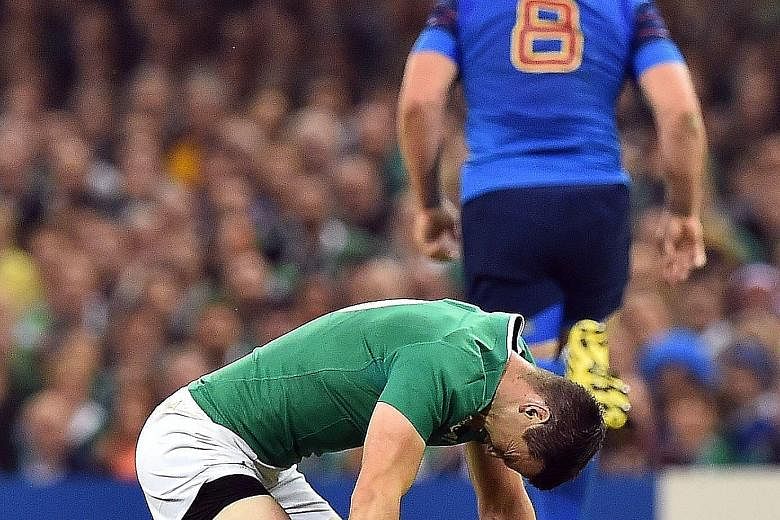LONDON • In a French newspaper, the Rugby World Cup was described as une hecatombe - carnage. If you were watching Ireland-France on Sunday, it was not hard to agree.
The attrition rate appears huge. Who knows if this Wales side were ever a team of potential World Cup winners? We will surely not find out now; already they have suffered too many blows.
A big injury or a sequence of injuries may act as a rallying call for the kind of extraordinarily spirited resistance that they displayed against England or that Ireland showed against France, but it cannot be sustained.
Some commentators wrote that Wales, on Saturday at Twickenham, lacked the guile to make their numbers count against a 13-man Australia who were hanging on after double yellow cards. What they really lacked, though, was players.
From their original squad of 47, they now have nine backs out injured; 10 if you include Jonathan Davies, a Lion.
Can Ireland now win? Has the attrition rate felled them, too? Peter O'Mahony and Paul O'Connell are out; for Jonathan Sexton, the key man, the word is "hopeful".
When two of the final eight teams are on their knees like this, rugby appears to have a problem.
Two out of eight is just further statistical evidence in the argument that professional rugby players have become so big and powerful that their sport ceases to work.
Here are some more stats that blur the picture. At this same stage of the competition four years ago, 19 players had been injured and withdrawn; in 2015, that figure is 22 but in 2007 it was 37.
Put it another way, in 2011, the average time each game stopped for injury was eight minutes. So far in 2015, it is just over five. Generally, statistics do not conclude injuries are on the rise.
I am also informed that players have got smaller. Not much. Forwards are 0.4 per cent shorter but 0.3 per cent heavier. Backs are 3 per cent lighter. Whichever way you assess size, though, it is conditioning and fitness that have changed unrecognisably; the significant factors, then, are the increased power of the collisions and the sheer number of them.
This is what can make a rugby field resemble une hecatombe and can cause an observer to conclude: this game is not for me.
Size and injury are rugby's problem, a fact of life in the professional game so visually highlighted on Sunday in Cardiff.
What is rugby doing about it? Certainly not standing by. Player welfare is regarded as a massive issue.
The game regularly revises its laws. Last year, global governing body World Rugby established an injury prevention group to make recommendations. The IPG studies footage of injuries to look at trends. The tackle and the ruck are the most dangerous elements of the game and they are now under specific review.
This is where the future of a dangerous sport is fascinating. There are 130 proposals at present for law changes, a few of which are being tested out. Somewhere a balance has to be struck. Where does physicality end and safety begin? How much might rugby have to change to find that balance?
Many rugby viewers will have their theories. Some suggest a total weight ceiling per team. This is not under review. What is under review is the legal height of a tackle. At present, a tackle can be no higher than the shoulders. If that comes down, it would present a very significant change to the way the game is played.
It would be extremely hard to referee. It would transform attacking into a far slicker offloading game. It would therefore make defending infinitely harder. And before you know it, the game has changed.
How do you like your rugby? The way it is, and the way it sometimes looks, the way it appeared on Sunday in Cardiff, and the way those quarter-finals now look with the chances of two of eight teams so hugely affected by their injury toll.
Change? Or just carry on? In the answer lies a great responsibility and the future of the game.
THE TIMES, LONDON

